If you take the Green Line from downtown, look west just before you reach the Ashland stop. You can peer through the second-floor window of a brick building and see workers shaping columns of wood on a lathe. That’s the Lyon & Healy factory. They make harps there.
That alone is probably not scintillating enough to compel you to pull the emergency brake to get a better view, but keep in mind that someone will eventually pay many thousands of dollars — in some cases, more than $100,000 — for just one of the instruments being crafted inside. Or consider that members of some of the world’s greatest orchestras, including the Chicago Symphony Orchestra and Berlin Philharmonic, to name just two, play them. That John Coltrane was so enamored he bought one. That the Metropolitan Museum of Art in New York has three in its permanent collection.
Once you come to learn of the craftsmanship involved, it’s no wonder these instruments are considered works of art. Each harp will be handled by 35 people — out of 120 woodworkers, gilders, and artists on staff — in the course of its construction. In fact, most of what goes on inside the West Town factory involves little machinery. Almost everything is done by hand, and some harps take more than a year to manufacture. A concert grand harp consists of approximately 2,000 parts. For comparison’s sake, the Statue of Liberty was assembled from 350, and she can’t even play music.
The harp is a lonely instrument — there are no harp sections in orchestras — but it doesn’t shy away from its stature. Much of a concert grand’s unmistakable tone owes to its massive size. Placing a harp in a chamber trio is like asking Shaquille O’Neal to officiate at your wedding: The effect is stunning, but it can be terribly unfair to the couple with whom it shares the stage. At a Philip Glass concert last summer, I saw him perform on piano alongside cellist Matt Haimovitz and harpist Lavinia Meijer. Her Lyon & Healy was more than six feet tall, with fleurs-de-lis carved into its intricate crown-topped column. As dignified as a cello or piano may be, each appeared and sounded plain next to Meijer’s Seussian device.
When harpists play a concert grand — like, really jam on one — they hug and cradle the fat end of the body while rocking the 80-pound frame back and forth. It looks not unlike someone trying to soothe a nervous Great Dane during a thunderstorm. I was spellbound by the sight of Meijer’s small hands flowing across the shimmering strings as she performed Glass’s hypnotic compositions.
The harp, particularly when it’s a first-class Lyon & Healy, has a tangible gravitational pull. I certainly felt it that evening. And the center of this particular universe is just a 10-minute train ride from downtown Chicago. I found myself wondering, How did this come to be?
All the bonny carvings of a present-day harp belie the fact that it’s one of the oldest musical instruments known to man, dating back to at least 3000 BC. While a concert grand is a bafflingly complex device, it evolved from the simple archer’s bow. The first harpist was most likely an absent-minded hunter who enjoyed the sound his weapon made as he plucked it. More strings were added over time, and the handheld folk harp, or Celtic harp, became the troubadour’s staple. The instrument was simple to a fault, and it couldn’t reach the multiple-octave ranges musicians were beginning to explore during the 17th and 18th centuries. To the virtuoso composers of the era, the harp was about as useful as a kazoo.
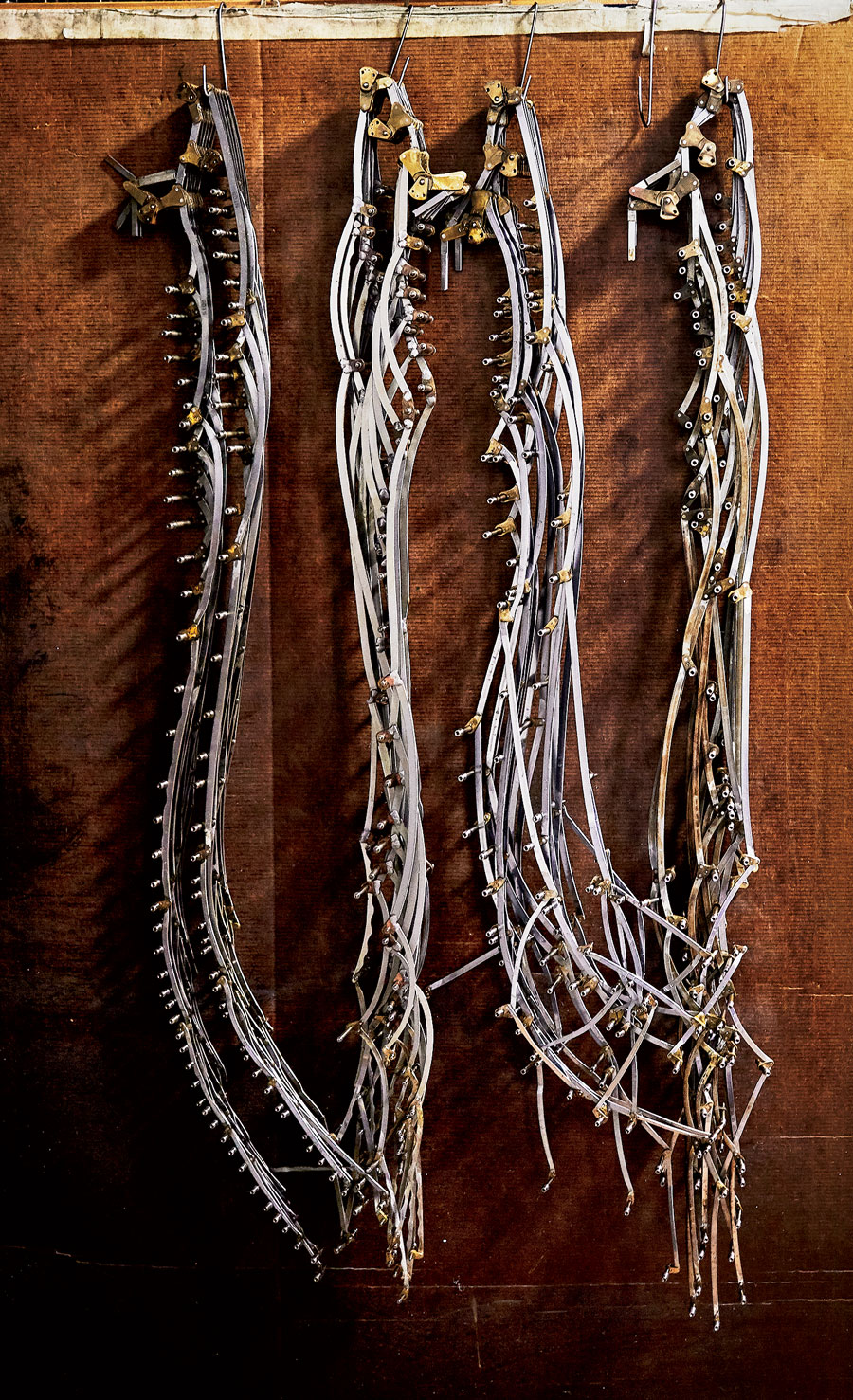
Around 1720, a Bavarian named Jacob Hochbrucker reverse-engineered a harp to hit a broader range of notes by installing pedals that stretched the strings to alter the sound. Marie Antoinette loved to play a gilded version, and this endorsement raised the harp’s profile among Europe’s upper crust. Craftsmen across the Continent took turns improving upon the design until Sébastien Érard patented the double-action pedal harp around 1810. His harp had seven pedals, one for each note across the heptatonic scale, and these attached to a mechanism equipped with rotating discs that tightened or loosened strings to make sharp, flat, and natural pitches. With this expanded range, composers no longer had to hold back when writing for the harp, and the instrument’s popularity grew as it became a common sight at symphonies. Yet as elegant as they may have been, the European models left two guys in the Midwest thoroughly unimpressed.
Patrick J. Healy and George W. Lyon moved to Chicago from Boston and opened a sheet music shop on the corner of Washington and Clark in 1864. Their store soon expanded to serve the more urgent needs of the city’s musicians, and Lyon & Healy shifted its focus to instrument sales and repairs. Those pretty European pedal harps were frequently in need of repair, as the finicky and delicate contraptions couldn’t handle Chicago’s wild temperature swings. There were other issues beyond durability: Even in perfect conditions, the sound of the imported harps varied greatly, and their inner workings often rattled and buzzed. Healy was especially perturbed. Hailing from Ireland, he grew up playing the Celtic harp and wanted to promote the instrument in all its forms. This wouldn’t be possible until the design was improved, so he embarked on a massive R&D project that would come to define his life.
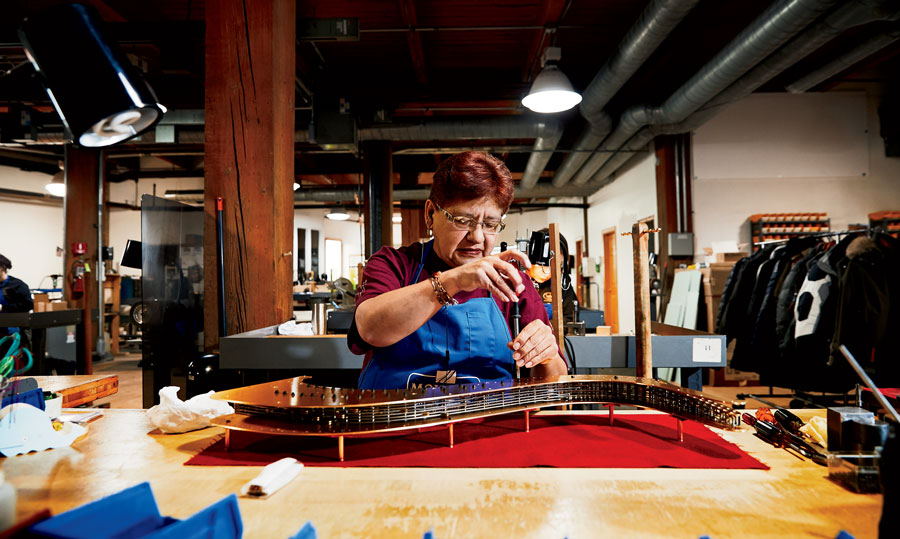
Healy devoted space in the company’s headquarters to this ambition. He put his best engineers on the job, and they essentially rebuilt the harp. His team invented a completely new and streamlined mechanism that gave harpists more control and reduced ambient buzzing. Stronger American timber allowed for greater string tension, and the soundboard — the wide, flat area on the harp’s body from which the strings sprout — was expanded to increase volume without sacrificing tone. This new configuration did more than handle the many octaves of Chicago’s weather; it produced the purest sound in the instrument’s 5,000-year history.
The first Lyon & Healy harp was released in 1889, and the timing couldn’t have been better. The company maintained a two-floor exhibition building at the 1893 World’s Columbian Exposition and hosted daily concerts for six months straight. Visitors from around the world were able to see and hear this new harp for themselves. There was some initial skepticism from Europe; one book on Healy later noted that critics in London asked, “Can a harp come out of Chicago?”
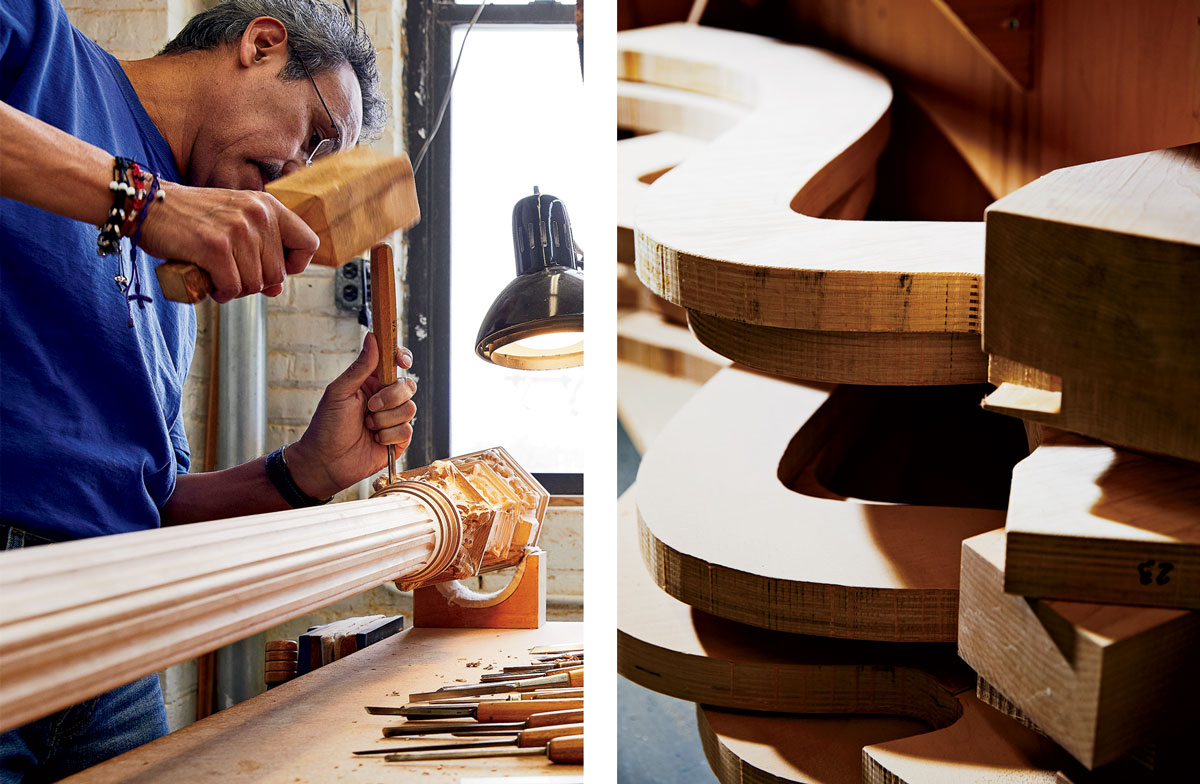
The answer was a definitive yes, and Chicago’s harp became the standard across the globe almost immediately. In 1895, Roman Mosshammer, the solo harpist at Vienna’s Royal Opera, called Lyon & Healy’s product “the most complete as regards tone and mechanism that has ever been accomplished.” Wilhelm Posse of the Berlin Royal Opera marveled that he could make the harp “sing” at its highest position (“the weak point of all other harps”). Carlos Salzedo, perhaps the most celebrated harpist in history, called the Lyon & Healy “the most beautiful and perfect instrument I have ever played.” He would later work with the company on a model called the Salzedo.
It took seven decades for Érard’s pedal harp to be usurped by the Lyon & Healy. Nearly twice that amount of time has passed since then, but the instrument — and the way it’s made — has remained largely unchanged.
They were really brilliant back then,” Steve Fritzmann, Lyon & Healy’s national sales manager, tells me. “They knew what they were doing.” Fritzmann is showing me around Lyon & Healy’s five-floor factory at Ogden and Lake.
Advertisement
He started at the company as a woodworking apprentice in the 1970s and moved his way up to the rank of master harp maker, a title reserved for those well versed in every step of the instrument’s construction.
We’re on the first floor, and nary a harp can be seen. This is the machine shop, where workers make the mechanism: the “brain” of the harp and the device that pulled the instrument out of the dark ages. More than a dozen blue-aproned men and women peer intently from behind safety goggles at their workstations. The setup is similar to a college chemistry lab.
The concert grand harp is probably the most complex instrument in the world, and the mechanism is by far its most complicated component. It’s shaped like a soft S and installed at the top, where it translates movement from the pedals to the strings. Thirty-six people work on the first floor, and it takes them nine days to build just one mechanism, which holds 1,500 of the nearly 2,000 parts that make up a pedal harp.
The mechanism works a bit like IBM’s early punch card machines, in that it takes a simple human input (the pressing of a pedal) and translates it through physical motion to provide an advanced output (the change of a specific pitch). The men and women on the first floor essentially spend their time assembling computers; their finished products just happen to create pretty music rather than, say, land a man on the moon.
Maria Serna, who has been with the company for 13 years, sits before a skeletal row of stainless steel spindles and carefully files rivets that have been peened to mushroom over their respective joints. If I didn’t know better, I would have guessed she was assembling an Erector Set, not part of a harp that will cost more than my car. “Each one of these spindles represents an octave,” Fritzmann says. These make up the linkage, the neural network of connective tissue between mechanism and musician.
When a harpist presses a pedal, it triggers rods running through the instrument’s column to a device called the main action. The linkage then translates this motion to rotate the appropriate gold-plated discs and alter the pitch of a specific series of strings. Should one of the spindles be too loose or too tight, the whole chain of events collapses. That’s how one wobbly rivet can ruin a performance of Debussy’s Danses at the London Symphony Orchestra.
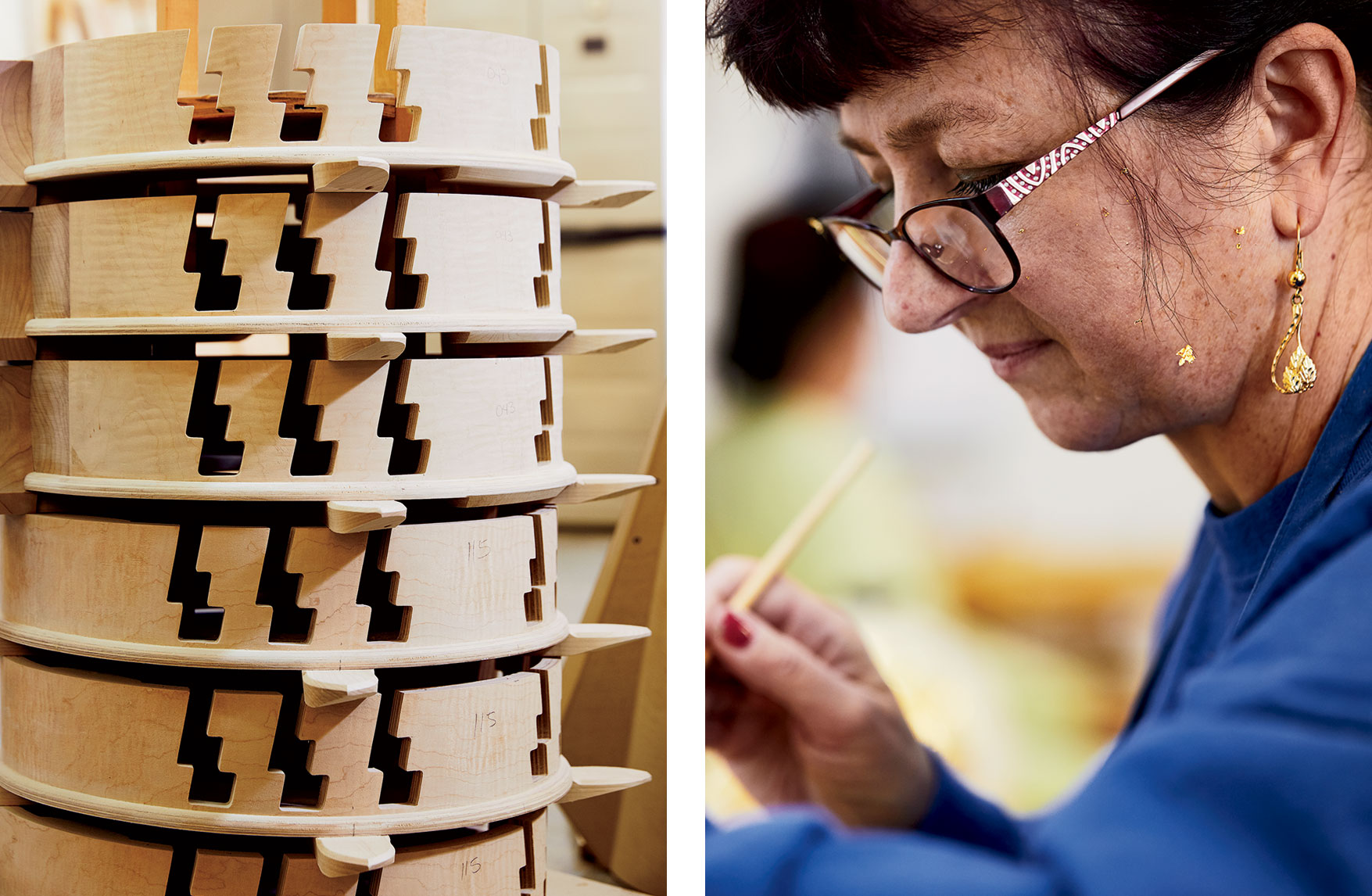
At an adjacent row of workbenches, Stanley Kwiatkowski, Lyon & Healy’s ace linkage inspector, carefully measures each connection and checks them for feel. I ask how many he goes through in a day. “A lot,” he says without looking up from his bench. At any given moment, about 20 mechanisms are being built on the first floor. I count 13 spindles riveted together on the linkage flopping in Kwiatkowski’s hands and do some back-of-the-napkin math. Twenty mechanisms equals 260 total linkages, which would mean that roughly 3,640 connections need to be checked today. In other words, a lot.
Most of the finished mechanism is obstructed from view, attached to the wooden frame, but it is nonetheless an object of real beauty. Each of the 47 strings on a pedal harp is wound through two rows of gold-plated discs that are affixed like gems on a crown. “It’s a visual thing,” Fritzmann says. “It’s jewelry.” But the precious metal was chosen for a practical purpose, too: It can grab bovine gut strings with enough suppleness to resist corrosion. Lyon & Healy sources its strings from a company in England that feeds its cows a special carrot-free diet (carotene stains their innards a very un-harp-like orange). It takes the small intestines of approximately 14 cows to string one harp.
The mechanism works because the men and women on the first floor know exactly how each of its 1,500 parts is supposed to feel in their hands. This vast tactile lexicon is one of Lyon & Healy’s most valuable assets. Few people can play the harp, but fewer still are able to touch a third octave’s linkage and determine whether it is too pliant.
Piles of steel spindles, metal bearings, and brass plates cover the benches in the machine shop, but the rest of the Lyon & Healy factory is a temple of wood. Even the service elevator is wainscoted in glossy veneer. The harp is just a highly refurbished tree, after all, and floors 2 through 4 make up a veritable forest.
Think about building an ornate armoire with your bare hands. Difficult, right? Now imagine that this is a curved armoire, one that must last for hundreds of years and amplify a very specific set of sounds to the back row of Lincoln Center’s uppermost balcony. This is the job of Lyon & Healy’s joiners, sanders, and carvers, the folks who turn raw lumber into harp-like objects in the factory’s second-floor wood shop.
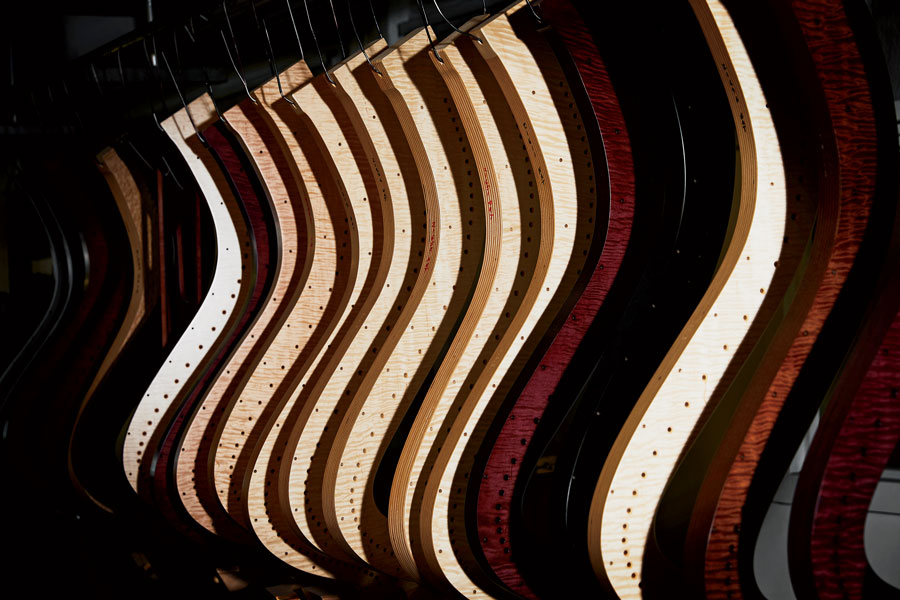
Lyon & Healy uses two types of wood to build its pedal harps. The body and soundboard are made from Sitka spruce, an evergreen native to the Pacific Northwest. Two workers examine sheets of sanded spruce and read the lines of grain like contractual small print. Every piece of a soundboard is culled from the same tree, and they are trying to find two exact matches — one panel to sit to the left of the strings, and one to be its mirror image on the right. The rings that once denoted the evergreen’s age will become the running track on which a harp’s sound travels; any arboricultural impurities could make for some unexpected snags.
Everything about the body of a harp is dedicated to sound. Screws, which can buzz, are avoided as much as possible. When they must be used, like in the attachment of the harp’s hidden aluminum ribs, they are given miniature leather washers to prevent reverberation. Crack open a harp (please don’t do this), and each screw will look as if it’s wearing a fashionable cowhide life vest.
The harp’s column, the thing you see being lathed when you look through the window from the L train, is the only straight line on the instrument’s frame. It’s made from sturdy maple harvested in the northern Midwest and takes much of the nearly 2,000 pounds of force that is exerted on the harp by those tightly wound cow intestines. A single piece of wood would be ideal for strength, but the column needs to sport a hollowed-out passageway to conceal the rods that connect its pedals to the mechanism. To create this elegant ductwork, four separate pieces of maple are glued together and sanded down to appear as one. The end product feels like velvet, so soft that you would consider sleeping on sheets made from sanded harp columns.
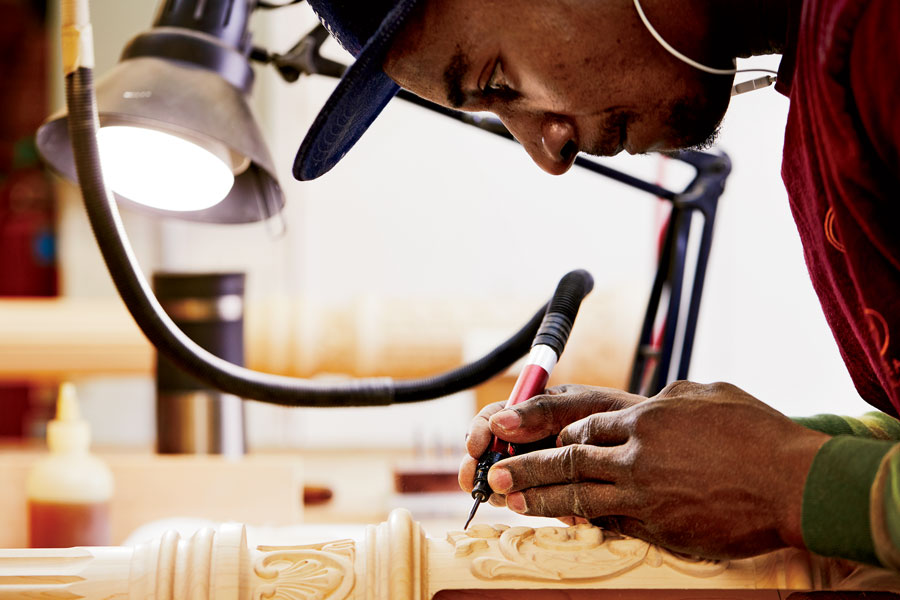
Once lathed, a harp column looks like a simple bedpost. The work really begins once one of the company’s carvers gets hold of it. The column boasts the instrument’s most elaborate flourishes, and each style of a Lyon & Healy concert grand has its own unique column design. While the company’s deco styles don’t require much sculpting (a Salzedo resembles the top of the Carbide & Carbon Building), the more baroque offerings can take a carver up to 200 hours. Raul Barrera, who has been working at Lyon & Healy for 33 years, is whittling a rose into the art nouveau column of a Style 11. He’s worked on so many harps that he can replicate the designs from memory, and I watch him chip a succulent petal onto a rose. When complete, a Style 11 will run you an average of $45,000 (depending on which variation you buy).
John Coltrane ordered a Style 11 from Lyon & Healy in 1967, but he never got to see the instrument for himself. “It took us a year to get it because they are practically handmade,” his wife, Alice, recalled in a radio interview in 1987. He died before it was delivered to their Long Island home, but Alice taught herself to play on it and would become the foremost practitioner of the harp in jazz music.
The Coltranes’ model was from Lyon & Healy’s premium line of gilded harps. The company’s student line debuted in 2008 and starts at $12,000. On the other end of the spectrum, Lyon & Healy’s highest-end harp is the extravagant Louis XV Special, which costs around $199,000. Only three of these harps have been sold since the model was introduced in 1916.
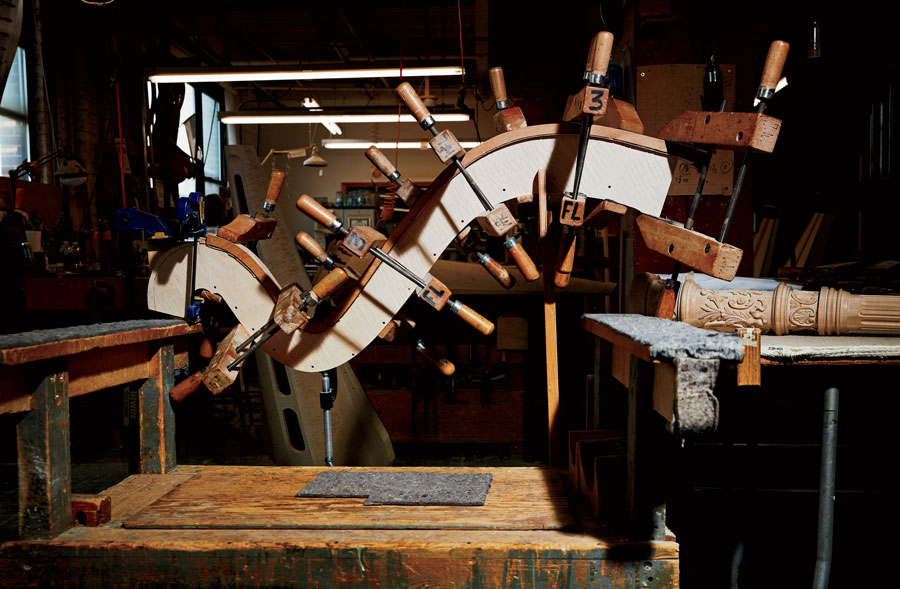
On the factory’s fourth floor is a dedicated gilding room, where a group of six women apply sheets of 23-karat gold leaf to columns with surgeon-like concentration. It is incredibly delicate work. The gold itself is so fragile that it disintegrates on my fingertip when I try to touch a small flake. The only way to pick up a piece of gold leaf without damaging it is by static electricity, so a gilder must rub a squirrel-hair brush on her face to generate the charge needed to attract one postcard-stamp-size sheet. The effect is stunning, both on the harps and the gilders themselves. When I enter the room, they briefly look up to acknowledge my presence, revealing cheeks speckled with gold.
The gilding is itself a form of sculpture, with texture and detail added piece by piece. Some sections of a column, like the crown of a Style 8, call for a more vibrant burnish, which requires more layers of leaf and more time. It can take more than a month to apply all the layers needed to gild a single harp, and each gilder stays with the same column from start to finish. “It’s a very hard job,” Barbara Urban, a gilder with 14 years of experience, tells me. “My favorite part is after I finish. People look at the harp and go, ‘Wow.’ ” Gilding also presents some unique occupational hazards. Urban sometimes forgets to wash her face before leaving work, and her husband will cheerily tease his “gold wife” when she returns home.
One would imagine that the manufacturer of niche instruments that can cost as much as single-family houses would struggle in tough economic times, but Lyon & Healy has proved surprisingly resilient. The company kept all 135 employees on its payroll through the 2008 recession despite a 25 percent drop in sales. Of its current employees, all but around a dozen are factory workers who have hands-on roles in building the harps.
Lyon & Healy also has the benefit of being owned by its only real competitor, Salvi Harps of Italy. Founder Victor Salvi grew up in the Chicago area and played Lyon & Healys throughout his career as a soloist. He moved to Italy to open his own harp factory in the 1950s. Salvi purchased Lyon & Healy in 1987 after he learned it had become insolvent under then-owner Steinway & Sons. His ultimate mandate was for the Chicago operation to keep making harps as it had been for nearly a century.
Advertisement
The sister companies now dominate the market. “In the major orchestras, they’re going to be playing either a Lyon & Healy or a Salvi 97, 98 percent of the time, and Lyon & Healy is the more predominant of those two,” Fritzmann says.
Around 15 years ago, the demand for harps dramatically increased in Asia. As a result, Lyon & Healy aggressively expanded in the Asian market, which helped boost export sales during the recession. (The most anyone at Lyon & Healy will say about the most recent buyer of a Louis XV Special is that he or she lives in South Korea.) The company now has eight technicians living in Asia to service those customers, as it’s easier and cheaper to ship people than harps. Lyon & Healy won’t send someone a harp if the temperature is below freezing or above 90 degrees at any part of the instrument’s journey, and the company maps out the entire route to ensure there are no intemperate stops along the way. It’s a chilly day when I visit, so the shipping dock is at a standstill.
Bill Yaros, an assistant production manager at Lyon & Healy, estimates the company makes and sells around 1,000 harps a year, with 300 to 400 of those being pedal harps. (The rest are simple Celtic harps and entry-level lever harps.) Yaros lived in Shanghai for three and a half years as one of the company’s satellite technicians, and he helped teach workers there how to perform basic maintenance. Given the sheer complexity of the instrument, building and repairing pedal harps is a feat that demands hyperspecialized apprenticeship and hands-on experience. “No one knows just how to make a harp randomly,” Yaros says.
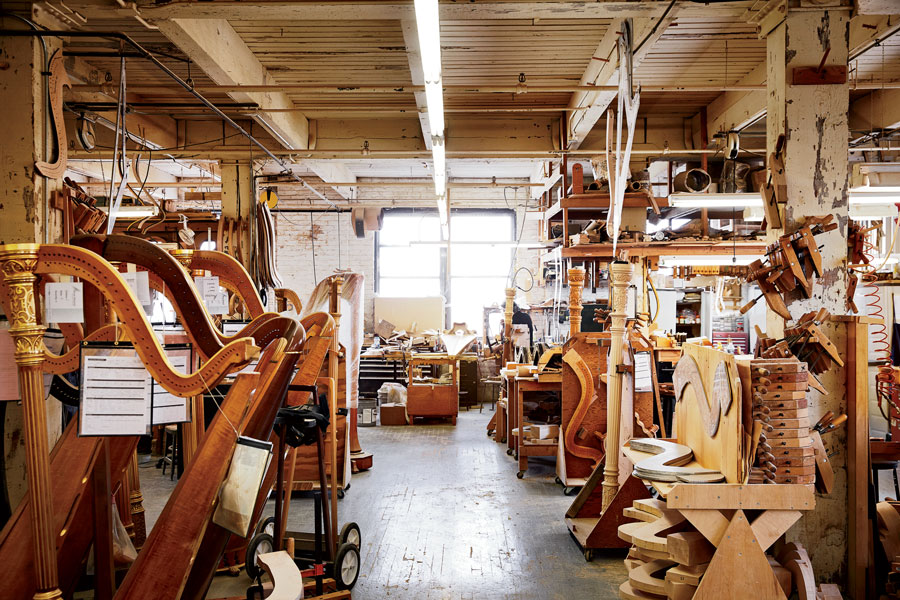
Most of the employees I encounter have been with the company for at least a decade. Hector Rivera, a master harp maker, is entering his 40th year at Lyon & Healy. “My uncle used to work here and in ’79 asked me if I wanted a job,” he says. “Baby was coming, and I thought the insurance would help, so I said sure.” Flash forward four decades, and Rivera is now one of the world’s most accomplished harp makers.
When I meet Rivera, he is repairing an instrument from the 1930s made by Wurlitzer, which was briefly based in Chicago and stopped making harps before World War II. Because most modern pedal harps are broadly modeled on Lyon & Healy designs, the company offers repair services for other brands as well. The base and neck of this particular harp have splintered apart, and Rivera has to rebuild each from scratch. There are no instruction manuals for this task. Some of the Wurlitzer’s accent pieces came from a species of rosewood tree that nearly went extinct in the 20th century and is now illegal to harvest. Rivera will have to make do with bubinga, a similar type of wood.
“This kind of trade has to be learned here,” he says. “It needs to be taught by people who already do it.” In its factory workers, Lyon & Healy preserves the complete knowledge of every aspect of the pedal harp, passed down from the original engineers who set out to build its best version back in the 1800s. When Morgan Park High School brought an old Lyon & Healy to the factory for service in 1979, the technicians were shocked to find that it was the very first pedal harp the company made. How it wound up in a school’s music room is a bit of a mystery, but Healy and his engineers would have been thrilled to learn that the instrument they built in 1889 didn’t just survive Chicago’s winters — it withstood the city’s teenagers as well. Lyon & Healy gave Morgan Park a replacement harp, and the original artifact now resides on display at the Victor Salvi Harp Museum in Piasco, Italy.
Perhaps the only thing more difficult than repairing a pedal harp is learning how to play one. Even the master harp makers leave it to the pros. “I’m a guitar player,” Fritzmann tells me. “Six strings is hard enough.” Simply finding a harp teacher is challenging, and getting to a level of basic proficiency can take an embarrassingly long time.
It’s a tad surprising, then, that the harp is enjoying something of a renaissance right now. Indie star Joanna Newsom has released a series of critically acclaimed psychedelic folk albums that have helped introduce harp music — and the Lyon & Healy Prince William Gold she plays — to a more pop-inclined audience. She has honest-to-goodness name recognition, something no American harpist has been able to claim since Harpo Marx (who also played a Lyon & Healy).
Avant-garde harpist Mary Lattimore, meanwhile, has garnered accolades by taking the instrument in surprising directions. New Yorker writer Hua Hsu recently praised Lattimore’s ability to make the harp “feel mortal and vulnerable.” On the phone from Los Angeles, Lattimore tells me: “There’s a lot of territory left to be explored on the instrument.” She takes a distinct pleasure in playing the harp in ways that “aren’t the cartoon version of people’s impression of the harp,” as she puts it. “It’s really cool to make it not so precious.”
Lattimore’s mother, a harp teacher and professional harpist, bought a used Lyon & Healy Style 30 from one of her students to give to her daughter when she graduated from high school. “It’s a 50-year-old harp, so it’s aged really well, sound-wise,” Lattimore says. Unprompted, she asks if I’ve been to the factory, and from there she reminisces about her own visit. “It made me rethink the care that I take with the instrument. When you see how it’s made, you’re like, ‘Oh gosh, I’m shoving it into the back of cars and vans when all this work has gone into it.’ ”
Lavinia Meijer, the musician whose performance with Philip Glass inspired my Green Line jaunt into the world of harps, has made multiple visits to the factory. Like Lattimore, Meijer is keen to dispel the notion that the harp is delicate. “You can play very soft and whispery, like silk,” she says from her home in the Netherlands. “But on the other hand, you can really be a beast on the instrument. You can make thunder and lightning. They’re strong instruments.”
Advertisement
Meijer is a Lyon & Healy devotee, and the company provides her with a Style 23 (valued between $34,000 and $56,000) when she is in the United States. (She plays her own Salzedo in Europe.) The company has been doing this in some form throughout its history, the kind of promotional savvy that has helped keep it in the public eye. In the 1930s, Lyon & Healy would send porters to move Harpo Marx’s instrument for him as he traveled the country. Whenever he arrived in a new town, his gilded concert grand would be waiting for him in his hotel room.
Lyon & Healy’s existence is directly tied to whether people continue to play the harp, and so the company has long been engaged in various ventures to promote the instrument. In the concert hall next to the showroom on the factory’s fifth floor, it hosts a live-music series and awards ceremony. Lyon & Healy also often lends out harps to organizations. (A loaner exhibited at the Illinois Governor’s Mansion is the subject of a friendly negotiation right now. The state doesn’t want to give it back.)
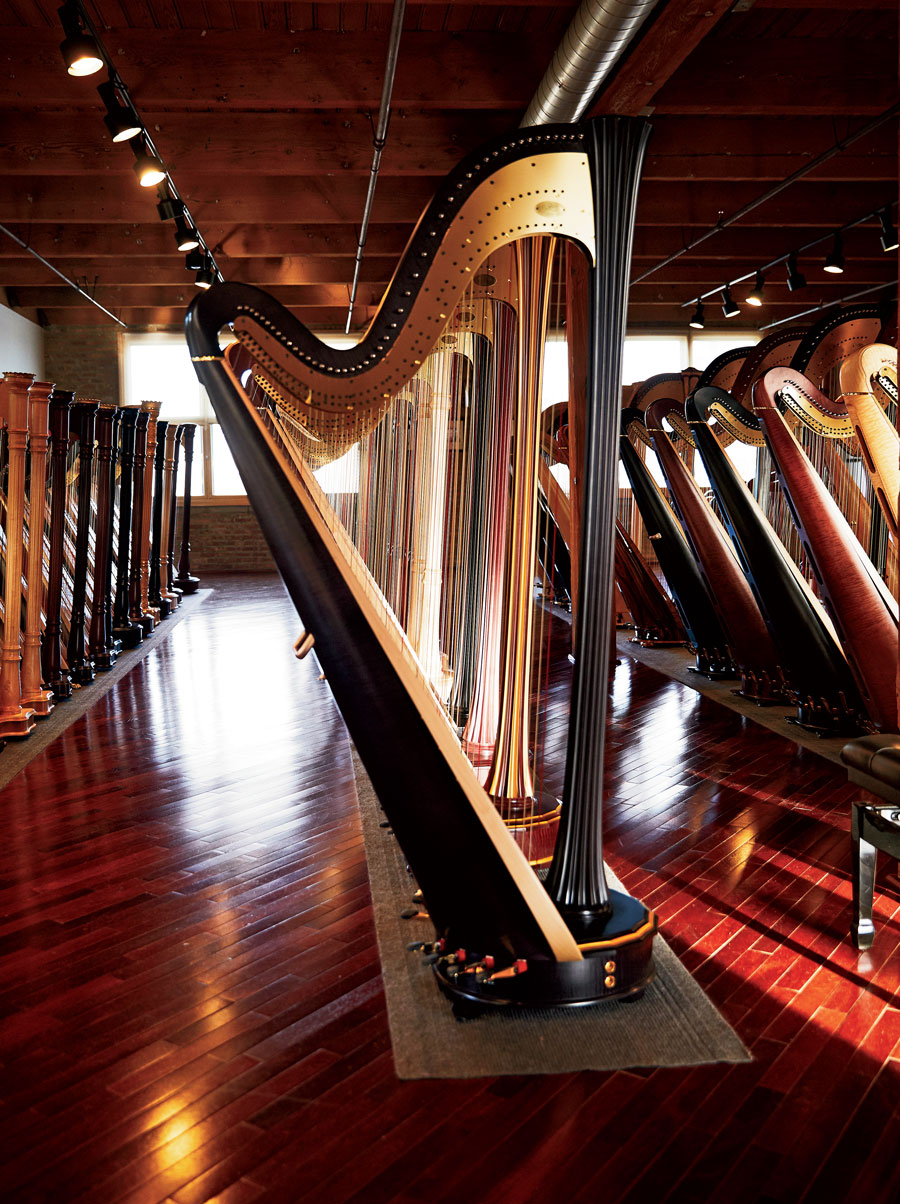
“It’s not a ‘need’ instrument, Fritzmann explains. “It’s not like guitars and pianos and drums and violins. It’s not something you are required to take in any class. It’s something that a person is drawn to, for whatever reason.” Meijer recalls how she was enchanted by the harp in elementary school: “I saw this mysterious instrument with a lot of strings, and it had a sound that was so pure. It was the purest sound I had ever heard.”
Harp frames dangle from hooks in a section of the fourth floor. It’s like a strange meat locker, one where sprayers apply lacquer and finish to each instrument, though a harp is never really finished. The felt pads in its pedal stops need to be replaced semiregularly. Its wood ages and the tone matures and, every few years, it cries out to be regulated.
Regulation is an advanced form of tuning that reaches deep into the instrument’s bones. Lyon & Healy employs seven full-time regulators, who use electronic strobe machines to get each and every pitch exactly right. “A harp needs to settle,” Fritzmann tells me in the tuning room on the fourth floor. It can take a week to regulate a concert grand, and every harp the company sells undergoes this process.
Professional harpist Jennifer Ruggieri represents the last check and final step of a harp’s production. She comes to the factory and plays the finished harps to make sure they are performance-ready before they are ushered into the showroom. Once there, a harp will wait quietly until it catches someone’s eye. Adorned with all its decorative flourishes, the instrument is designed to mesmerize at first sight.
Elisabeth Remy Johnson, the principal harpist for the Atlanta Symphony Orchestra, traveled to Chicago in February to pick out a new concert grand. It’s a big, expensive decision. “You’re establishing what you want your voice to sound like,” she tells me. Ahead of her visit, she sent a recording of an old CBS Symphony Orchestra performance to Natalie Bilik, Lyon & Healy’s national sales manager. “I told her, ‘I know this is from 1949, but I just love the sound of the harp.’ ” Bilik studied the recording and selected a few models from the showroom that closely matched the timbre.
Johnson played chamber pieces on the harps in one of the small rehearsal spaces adjacent to the showroom. She then moved to the more capacious environment of the concert hall and really let it rip. Each harp had its own character, but she formed a bond with one particular Salzedo. “It was almost as if the strings were already vibrating before I played them,” she tells me. “The sound was so immediate.” Bilik estimated that the CBS Symphony Orchestra harp was itself 20 years old at the time of the 1949 recording, but the model in Johnson’s hands managed to match its deep and mature resonance.
This will be Johnson’s second Lyon & Healy Salzedo. When it arrives, she will use its packaging to send the other back to Chicago for a tune-up. Most likely, she will play both instruments for the rest of her life.



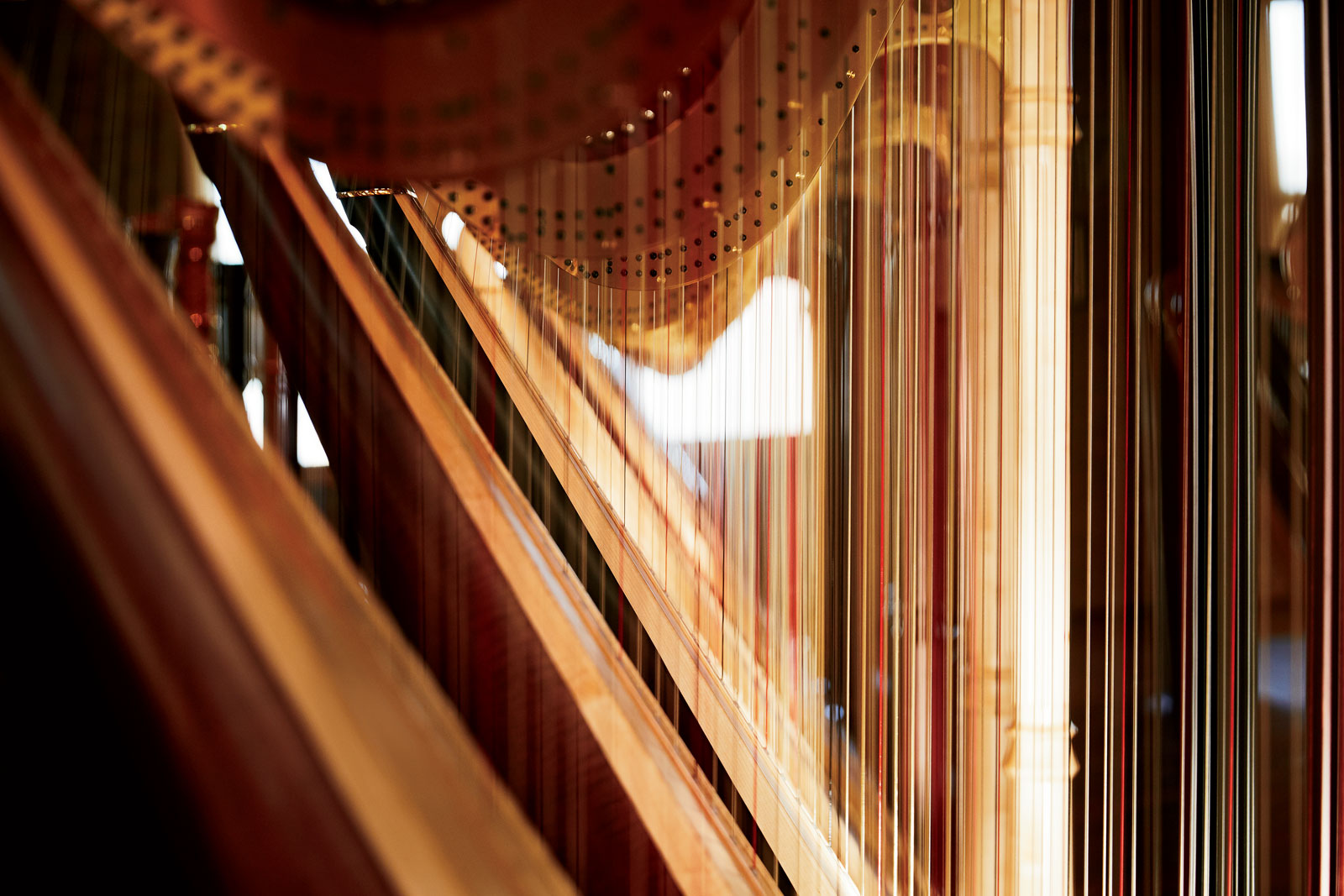
Comments are closed.